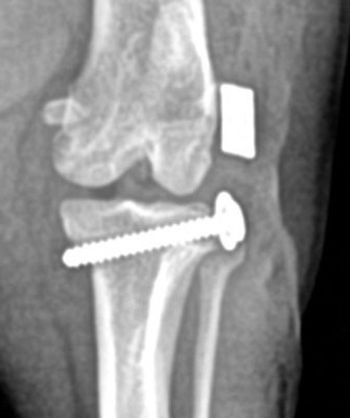
The pathophysiology of zinc's adverse effects
A key to diagnosing zinc toxicosis is understanding what adverse affects it can cause in the body.
A key to diagnosing zinc toxicosis is understanding what adverse affects it can cause in the body.
Hemolysis
Zinc toxicosis leads to intravascular hemolysis.1-7 The pathophysiology of zinc-induced hemolysis is not completely understood. Theories are that zinc causes inhibition of glutathione reductase and enzymes of the hexose-monophosphate shunt pathway.5 The absence of these enzymes make RBCs are more susceptible to oxidative injury. Thus, oxidative damage of RBCs leads to Heinz body formation and hemolytic anemia. Hemolytic anemia is caused by the hemolysis of RBCs from inhibition of RBC enzymes, direct damage to RBC membranes by zinc, hapten-induced immune destruction, or some combination of these. The hapten-induced immune destruction of RBC membranes may explain why spherocytes can sometimes be seen in cases of zinc toxicosis as well.5,8,9
Pancreatitis
Pancreatitis is also reported with zinc toxicosis.3,4,10-12 Zinc is excreted by pancreatic secretions. Excessive zinc accumulation within the pancreas may cause structural damage to pancreatic acinar cells, thus releasing pancreatic enzymes and resulting in pancreatitis.12 Hypoxia and ischemia from hemolytic anemia have also been suggested in the human literature as contributing causes of pancreatitis.12 Pancreatic fibrosis was noted on necropsy in a case report of a 13-year-old dog that succumbed to zinc toxicosis from ingestion of a penny.11 The significance of this finding is unknown, but pancreatic fibrosis would indicate a chronic process vs. an acute toxic change.
Coagulopathies
Coagulopathy has been documented in dogs as well. In some cases only prolonged activated clotting times and partial thromboplastin times were noted.2-4,12 The causes of this are speculative, but zinc may cause an inhibition of clotting factors VIII, IX, XI, and XII (factors of the intrinsic pathway) by an unknown mechanism.2 Disseminated intravascular coagulation (DIC), thrombocytopenia, or both have also been demonstrated.2-4,7 Also, pancreatitis can lead to systemic inflammatory response syndrome (SIRS), which in turn can lead to DIC.
Acute renal failure
Acute renal failure is another reported finding.4,13 Renal failure may develop because of the direct toxic effects of hemoglobin from hemolysis to the renal tubules. Also, if a patient develops pancreatitis that leads to SIRS, then acute renal failure may be a sequela of ischemic injury. Heavy metals are also known to be directly toxic to renal tubular epithelium.2,4,5
Neurotoxicity
Zinc-associated neurotoxicity has been mentioned in a few case reports.5,14 One report documented a two-day history of seizures, but no histologic lesions were found in the central nervous system, so conclusions were unclear.5 In another report a 3-month-old puppy with vomiting and diarrhea of four days’ duration was presented for evaluation because of depression and continuous howling.14
Zinc has a high affinity for phospholipids. Thus, zinc can bind rapidly to neuronal cell membranes. Metallothioneins, one of the proteins that zinc binds to, are present in all brain cells, and they protect the neurons from increased intracellular levels of zinc.9
Zinc neurotoxicity is thought to be caused by apoptosis and necrosis of neurons.14,15 This may arise from several different mechanisms. First, generation of free radicals occurs after zinc binds to neuronal membranes and interacts with membrane-bound enzymes. Second, impairment in mitochondrial function occurs by depletion of cellular nicotinamide adenine dinucleotide (NAD). Depletion of NAD inhibits glycolysis and limits the electron transport chain, which induces reactive oxygen species.14,16
REFERENCES
1. Meurs KM, Breitschwerdt EB. CVT update: zinc toxicity, In: Bonagura JD, ed. Kirk’s current veterinary therapy XII small animal practice. Philadelphia, Pa: WB Saunders, 1995;238-239.
2. Meurs KM, Breitschwerdt EB, Baty CJ, et al. Postsurgical mortality secondary to zinc toxicosis in dogs. Vet Hum Toxicol 1991;33(6):579-583.
3. Gurnee CM, Drobatz KJ. Zinc intoxication in dogs: 19 cases (1991-2003). J Am Vet Med Assoc 2007;230(8):1174-1179.
4. Breitschwerdt EB, Armstrong PJ, Robinette CL, et al. Three cases of acute zinc toxicosis in dogs. Vet Hum Toxicol 1986;28(2):109-117.
5. Luttgen PJ, Whitney MS, Wolf AM, et al. Heinz body hemolytic anemia associated with high plasma zinc concentration in a dog. J Am Vet Med Assoc 1990;197(10):1347-1350.
6. Torrance AG, Fulton RB Jr. Zinc-induced hemolytic anemia in a dog. J Am Vet Med Assoc 1987;191(4):443-444.
7. Latimer KS, Jain AV, Inglesby HB, et al. Zinc-induced hemolytic anemia caused by ingestion of pennies by a pup. J Am Vet Med Assoc 1989;195(1):77-80.
8. Cahill-Morasco R, DePasquale MA. Zinc toxicosis in small animals. Compend Contin Educ Pract Vet 2002;24(9):712-720.
9. Cummings JE, Kovacic JP. The ubiquitous role of zinc in health and disease. J Vet Emerg Crit Care 2009;19(3):215-240.
10. Smith BL, Embling PP. Sequential changes in the development of the pancreatic lesion of zinc toxicosis in sheep. Vet Pathol 1993;30(3):242-247.
11. Shaw DP, Collins JE, Murphy MJ. Pancreatic fibrosis associated with zinc toxicosis in a dog. J Vet Diagn Invest 1991;3(1):80-81.
12. Mikszewski JS, Saunders HM, Hess RS. Zinc-associated acute pancreatitis in a dog. J Small Anim Pract 2003;44(4):177-180.
13. McKinney PE, Brent J, Kulig K. Acute zinc chloride ingestion in a child: local and systemic effects. Ann Emerg Med 1994;23(6):1383-1387.
14. Gandini G, Bettini G, Pietra M, et al. Clinical and pathological findings of acute zinc intoxication in a puppy. J Small Anim Pract 2002;43(12):539-542.
15. Marin P, Israël M, Glowinski J, et al. Routes of zinc entry in mouse cortical neurons: role of zinc-induced neurotoxicity. Eur J Neurosci 2000;12(1):8-18.
16. Sheline CT, Behrens MM, Choi DW. Zinc-induced cortical neuronal death: contribution of energy failure attributable to los of NAD(+) and inhibition of glycolysis. J Neurosci 2000;20(9):3139-3146.
Newsletter
From exam room tips to practice management insights, get trusted veterinary news delivered straight to your inbox—subscribe to dvm360.




